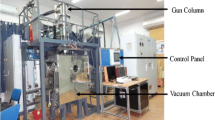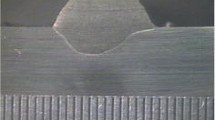Abstract
Bead-on-plate welding of zircaloy-4 (a reactive material) plates was conducted using electron beam according to central composite design of experiments. Its predictive models were developed in the form of knowledge-based systems in both forward and reverse directions using neural networks. Input parameters considered for this welding of reactive metals were accelerating voltage, beam current and weld speed. The responses of the welding process were measured in terms of bead width, depth of penetration and micro-hardness. Forward mapping of the welding process was conducted using regression analysis, back-propagation neural network (BPNN), genetic algorithm-tuned neural network (GANN) and particle swarm optimization algorithm-tuned neural network (PSONN). Reverse mapping of this process was also carried out using the BPNN, GANN and PSONN-based approaches. Neural network-based approaches could model this welding process of reactive material in both forward and reverse directions efficiently, which is required for the automation of the same. The performance of the neural network models was found to be data-dependent. The BPNN could outperform the other two approaches for most of the cases but not all in both the forward and reverse mappings.


















Similar content being viewed by others
Notes
Technical Data Sheet of Reactor grade zirconium available from http://www.atimetals.com.
Available from http://www.cs.ru.nl/~peterl/eolss.pdf.
Available from http://www.minitab.com.
References
Ahmad, M., Akhter, J. I., Shaikh, M. A., Akhtar, M., Iqbal, M., & Chaudhary, M. A. (2002). Hardness and microstructural studies of electron beam welded joints of Zircaloy-4 and stainless steel. Journal of Nuclear Materials, 301, 118–121.
Amarnath, M. V. V., & Pratihar, D. K. (2009). Forward and reverse mappings of TIG welding process using radial basis function neural networks (RBFNNs). In Proceedings of IMechE, Part B: Journal of Engineering Manufacture (Vol. 223, pp. 1575–1590).
Benyounis, K. Y., Olabi, A. G., & Hashmi, M. S. J. (2005). Effect of laser welding parameters on the heat input and weld-bead profile. Journal of Materials Processing Technology, 164–165, 978–985.
Bhadeshia, H. K. D. H. (1999). Neural networks in materials science. ISIJ International, 39(10), 967–975.
Chi, C. T., & Chao, C. G. (2007). Characterization on electron beam welds and parameters for AZ31B-F extrusive plates. Journal of Material Processing Technology, 182, 369–373.
Choi, B. H., & Choi, B. K. (2008). The effect of welding conditions according to mechanical properties of pure titanium. Journal of Materials Processing Technology, 201, 526–530.
Cook, G., Barnett, R. J., Andersen, K., & Strauss, A. M. (1995). Weld modeling and control using artificial neural networks. IEEE Transactions on Industry Applications, 31(6), 1484–1491.
Dey, V., Pratihar, D. K., & Datta, G. L. (2010). Forward and reverse modeling of electron beam welding process using radial basis function neural networks. International Journal of Knowledge-based and Intelligent Engineering Systems, 14(4), 201–215.
Dey, V., Pratihar, D. K., Datta, G. L., Jha, M. N., Saha, T. K., & Bapat, A. V. (2010). Optimization and prediction of weldment profile in bead-on-plate welding of Al-1100 plates using electron beam. International Journal of Advanced Manufacturing Technology, 48, 513–528.
Dey, V., Pratihar, D. K., Datta, G. L., Jha, M. N., Saha, T. K., & Bapat, A. V. (2009). Optimization of bead geometry in electron beam welding using a Genetic Algorithm. Journal of Materials Processing Technology, 209, 1151–1157.
Dutta, P., & Pratihar, D. K. (2007). Modeling of TIG welding process using conventional regression analysis and neural network-based approaches. Journal of Materials Processing Technology, 184, 56–68.
Elmer, J. W., Giedt, W. H., & Eagar, T. W. (1990). The transition from shallow to deep penetration during electron beam welding. Welding Journal, 69(5), 167s–176s.
Ganjigatti, J. P., Pratihar, D. K., & RoyChoudhury, A. (2007). Global versus cluster-wise regression analyses for prediction of bead geometry in MIG welding process. Journal of Materials Processing Technology, 189, 352–366.
Gunaraj, V., & Murugan, N. (1999). Application of response surface methodology for predicting weld bead quality in submerged arc welding of pipes. Journal of Materials Processing Technology, 88, 266–275.
Gunaraj, V., & Murugan, N. (1999). Prediction and comparison of the area of the heat affected zone for the bead-on-plate and bead-on-joint in submerged arc welding of pipes. Journal of Materials Processing Technology, 95, 246–261.
Gunaraj, V., & Murugan, N. (2000). Prediction and optimization of weld bead volume for the submerged arc process—Part 1. Welding Journal, 78, 286s–294s.
Gunaraj, V., & Murugan, N. (2000). Prediction and optimization of weld bead volume for the submerged arc process—Part 2. Welding Journal, 78, 331s–338s.
Hashimoto, T., & Matsuda, F. (1965). Effect of welding variables and materials upon bead shape in electron beam welding. Transactions of NIRM, 7(3), 96–109.
Ho, C. Y. (2005). Fusion zone during focused electron-beam welding. Journal of Materials Processing Technology, 167, 265–272.
Huang, W., & Kovacevic, R. (2011). A neural network and multiple regression method for the characterization of the depth of weld penetration in laser welding based on acoustic signatures. Journal of Intelligent Manufacturing, 22(2), 131–143.
Jha, M. N., Pratihar, D. K., Dey, V., Saha, T. K., & Bapat, A. V. (2011). Study on electron beam butt welding of austenitic stainless steel 304 plates and its input-output modeling using neural networks. In Proceedings of IMechE, Part B: Journal of Engineering Manufacture (Vol. 225, pp. 2051–2070).
Kannatey, E. A. (2009). Willey series on processing of engineering materials. In Principles of laser materials processing.
Kennedy, J., & Eberhart, R. (1995). Particle swarm optimization. In Proceedings of IEEE International Conference on Neural Networks (pp. 1942–1948). Perth, Australia.
Kim, D., Rhee, S., & Park, H. (2002). Modeling and optimization of a GMA welding process by genetic algorithm and response surface methodology. International Journal of Production Research, 40(7), 1699–1711.
Kim, D., Kang, M., & Rhee, S. (2005). Determination of optimal welding conditions with a controlled random search procedure. Welding Journal, 90(8), 125s–130s.
Klemens, P. G. (1969). Energy considerations in electron beam welding. Journal of Electrochemical Society: Electochemical Science, 116(2), 196–198.
Koleva, E. (2001). Statistical modeling and computer programs for optimization of the electron beam welding of stainless steel. Vacuum, 62, 151–157.
Koleva, E. (2005). Electron beam weld parameters and thermal efficiency improvement. Vacuum, 77, 413–421.
Lancaster, J. F. (1970). The metallurgy of welding, brazing and soldering. London: George Allan and Unwin.
Lin, H. L. (2012). The use of the Taguchi method with grey relational analysis and a neural network to optimize a novel GMA welding process. Journal of Intelligent Manufacturing, 23(5), 1671–1680.
Miyazaki, T., & Giedt, W. H. (1982). Heat transfer from an elliptical cylinder moving through an infinite plate applied to electron beam welding. International Journal of Heat and Mass Transfer, 25(6), 807–814.
Mollah, A. A., & Pratihar, D. K. (2008). Modeling of TIG welding and abrasive flow machining processes using radial basis function networks. International Journal of Advanced Manufacturing Technology, 37(9–10), 937–952.
Montgomery, D. C. (1997). Design and analysis of experiments. New York: Wiley.
Nagesh, D. S., & Datta, G. L. (2002). Prediction of weld bead geometry and penetration in shielded metal-arc welding using artificial neural networks. Journal of Materials Processing Technology, 123, 303–312.
Okuyucu, H., Kurt, A., & Arcaklioglu, E. (2007). Articial neural network application to the friction stir welding of aluminum plates. Materials and Design, 28, 78–84.
Olabi, A. G., Casalino, G., Benyounis, K. Y., & Hashmi, M. S. J. (2006). An ANN and Taguchi algorithms integrated approach to the optimization of CO2 laser welding. Advances in Engineering Software, 37, 643–648.
Petrov, P., Georgiev, C., & Petrov, G. (1998). Experimental investigation of weld pool formation in electron beam welding. Vacuum, 51, 339–343.
Pratihar, D. K. (2008). Soft computing. India, New Delhi: Narosa Publishing House.
Rao, K. P., Angamuthu, K., & Srinivasan, P. B. (2008). Fracture toughness of electron beam welded Ti6Al4V. Journal of Materials Processing Technology, 199, 185–192.
Rudling, P., Strasser, A., & Garzarolli, F. (2007). Welding of Zirconium alloys, IZNA7 special topic report Welding of Zirconium Alloys.
Saha, T. K., & Ray. A. K. (2008). Vacuum—the ideal environment for welding of reactive materials. Journal of Physics: Conference Series, 114. doi:10.1088/1742-6596/114/1/012047.
Saresh, N., Pillai, M. G., & Mathew, J. (2007). Investigations into the effects of electron beam welding on thick Ti-6Al-4V titanium alloy. Journal of Materials Processing Technology, 192–193, 83–88.
Tay, K. M., & Butler, C. (1997). Modelling and optimizing of a MIG welding process a case study using experimental designs and neural networks. Quality and Reliability Engineering International, 13, 61–70.
Thomas, G., Ramchandra, V., Ganeshan, R., & Vasudevan, R. (1993). Effect of pre- and post-weld heat treatments on the mechanical properties of electron beam welded Ti-6Al-4V alloy. Journal of Material Science, 28, 4892–4899.
Tonpe, S., Saibaba, N., Jayaraj, R. N., Ravi Shankar, A., Mudali, U. K., & Raj, B. (2011). Process development for fabrication of Zircaloy-4 dissolver assembly for reprocessing of spent nuclear fuel. Energy Procedia, 7, 459–467.
Vijayan, T., & Rohatgi, V. K. (1984). Physical behaviour of electron-beam fusion heat transfer and deep penetration in metals. International Journal of Heat and Mass Transfer, 27(11), 1985–1998.
Vitek, J. M., Iskander, Y. S., Oblow, E. M., et al. (1998). Neural network modeling of pulsed-laser weld pool shapes in aluminum alloy weld. In Proceedings of 5th international conference on trends in welding research, Pine Mountain, GA (pp. 442–448) June 1–5. ASM, International.
Yang, L. J., Bibby, M. J., & Chandel, R. S. (1993). Linear regression equations for modeling the submerged-arc welding process. Journal of Materials Processing Technology, 39, 33–42.
Acknowledgments
The authors are grateful to Dr. L. M. Gantayet, Director, Beam Technology Development Group, Bhabha Atomic Research Centre (BARC), Mumbai, India, for his guidance and constant encouragement for this research work. Thanks are also due to Shri Joy Mittra, Shri Santosh Kumar and Shri L. D. Verma of BARC for their whole-hearted support during various stages of this research work. This work was supported by the Department of Atomic Energy (DAE), Government of India, [Grant number 2005/34/22-BRNS/2662 Dt. 26.02.07].
Author information
Authors and Affiliations
Corresponding author
Appendix: Photographs showing the shapes of fusion zone for some of the EB-welded samples of Zirclaoy-4
Appendix: Photographs showing the shapes of fusion zone for some of the EB-welded samples of Zirclaoy-4

Rights and permissions
About this article
Cite this article
Jha, M.N., Pratihar, D.K., Bapat, A.V. et al. Knowledge-based systems using neural networks for electron beam welding process of reactive material (Zircaloy-4). J Intell Manuf 25, 1315–1333 (2014). https://doi.org/10.1007/s10845-013-0732-3
Received:
Accepted:
Published:
Issue Date:
DOI: https://doi.org/10.1007/s10845-013-0732-3




